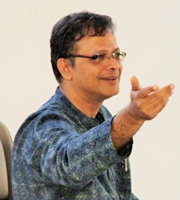


The original draft of the novel was around 750,000 words, three times the length of War and Peace. An earlier version of the novel was written in the form of a memoir, but was rewritten as fiction after it began to take an emotional toll on Pinto. While generally categorised as fiction, the book draws heavily on Pinto's upbringing as a Goan Catholic in Mumbai, and his family's struggle with his own mother's bipolar disorder. The non-linear storyline chronicles the life of the family, from the early lives of Imelda and Augustine (known by their children as 'Em' and 'The Big Hoom') to the family's chaotic struggle with Em's bipolar disorder, her euphoric flamboyance, strange charm, and paranoid attempts at suicide. The foundation of the book is built on the unusual relationships within the Mendes family: Imelda, Augustine, their daughter Susan, and their unnamed son from whose perspective the book is narrated. The book won The Hindu Literary Prize, the Crossword Book Award, the Sahitya Akademi Award, and the Windham–Campbell Literature Prize. Yale University Press, 1985.Em and the Big Hoom is a 2012 English-language novel written by Jerry Pinto.

“My Mother’s Breast.” A Book of Light: When a Loved One Has a Different Mind, edited by Jerry Pinto, Speaking Tiger, 2016, pp. “Introduction.” A Book of Light: When a Loved One Has a Different Mind, edited by Jerry Pinto, Speaking Tiger, 2016, pp. “India and the Right to Suicide.” New York Times. Writing at the Margin: Discourse between Anthropology and Medicine. The Illness Narratives: Suffering, Healing and the Human Condition. “India’s Mental Health Crisis.” The Editorial Board, New York Times. Translated by Mahadev Desai, Beacon, 1993. An Autobiography: The Story of My Experiments with Truth.

“Identity, Disability, and Schizophrenia: The Problem of Chronicity.” Knowledge, Power and Practice: The Anthropology of Medicine and Everyday Life, edited by Shirley Lindenbaum and Margaret Lock, University of California Press, 1993, pp. This process is experimental and the keywords may be updated as the learning algorithm improves.Įstroff, Sue. These keywords were added by machine and not by the authors. Both these novels offer readers complex narratives that bear witness to suffering, making a moving and powerful argument for listening and acknowledging the humanity of people dealing with disability and chronic mental illnesses, refusing to see them merely as patients or political actors with specific agendas. Drawing upon Arthur Kleinman’s model of resistance and suffering in the context of the lived, embodied experiences of patients, families, and caregivers, this chapter studies the struggle to construct meaning in a world that resists it. This chapter examines two novels that deal with the issue of mental illness and psychiatric disability in the Indian context, Amandeep Sandhu’s Sepia Leaves and Jerry Pinto’s Em and the Big Hoom.


 0 kommentar(er)
0 kommentar(er)
